Health Management
Declaration on Health Management (Approaches and Policy)
Included in the Group's Corporate Principles is "placing importance on personnel." Based on the idea that the source of the Group's competitiveness lies in the capabilities of its employees, we seek to raise productivity by enhancing employees' well-being* and to maintain high performance as an organization in the future. To this end, we are undertaking strategic measures to promote heath management.
- *Well-being: good physical, mental, and social condition
Promotion System
The Group appointed the executive in charge of human resources as Chief Health Officer (CHO) to promote health management. Executives from each Group company are also actively involved in the promotion. The Group issues a "White Book on Health" annually that analyzes the health status of all Group executives and employees. We also identify issues, and evaluate and improve our initiatives at a Group-wide "Promote Health Management Meeting*" chaired by the CHO which is held every quarter, thereby implementing the PDCA cycle for health management.
We have been selected as a "Health & Productivity Stock," which is jointly organized by the Ministry of Economy, Trade and Industry and the Tokyo Stock Exchange, for ten consecutive years since 2015 and selected as "Certified Health & Productivity Management Outstanding Organization (White 500)" by the Nippon Kenko Kaigi nine times.
- *Held with the participation of executives in charge of human resources at Group companies as well as the employee unions and the Health Insurance Society
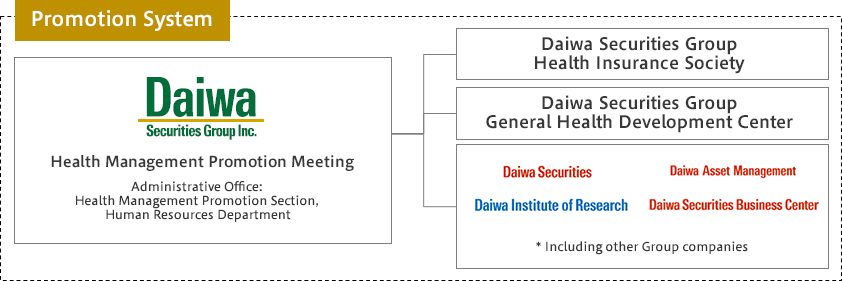
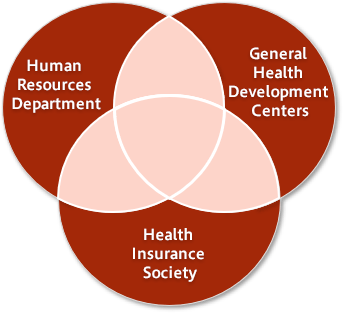
Also, the Human Resources Department, General Health Development Centers (infirmaries), and Health Insurance Society closely cooperate and work together. The three parties collaborate with each other, planning and disseminating health measures, and have increased the effectiveness of such measures by exchanging opinions on a daily basis.
History so far
| Main achievements | External Evaluations | |
|---|---|---|
| FY2008 |
|
|
| FY2009 |
|
|
| FY2010 | Started walking and quit smoking challenges | |
| FY2011 | Started "Eating to 80% full" (Harahachi) campaign | |
| FY2012 | Started Red Case Support Program (for severely ill persons) | |
| FY2013 | Received the Minister of Health, Labour and Welfare "Extending Healthy Life Expectancy Award" | |
| FY2014 | Our Group's efforts were published in the "Ministry of Health, Labour and Welfare White Paper" |

|
| FY2015 |
|

|
| FY2016 | KA-RA-DA iki-iki Project Introduction |

|
| FY2017 | Introduced Employment Support Plan for Employees with Cancer |

|
| FY2018 | Introduced Daiwa ELLE Plan |

|
| FY2019 |
|

|
| FY2020 | Introduced Daiwa Online Care |

|
| FY2021 |
|

|
| FY2022 |
|

|
| FY2023 |
|

|
| FY2024 |
|

|
Targets
To measure the improvement of productivity through health management, we use presenteeism*1 and absenteeism*2 as indicators.
| Indicator | Target (FY2030) |
|---|---|
| Percentage of loss from presenteeism | Less than 10.0% |
| Average of absenteeism | 3.0 days or less |
- *1The state of the employee's work execution ability and productivity declining as a result of coming to work while suffering from some disease or symptom. Calculated by conducting a survey in which employees evaluate their own work in the past four weeks with the work they can perform when having no illness or injury set at 100%. The smaller the value, the higher their productivity.
- *2The state of being absent or on leave due to illness. Calculated by conducting a survey that asks how many days employees were absent due to illness in the past one year. The fewer the days, the higher their productivity.
Various Health Measures, Their Effects, and Connections with Management Goals Pursued in Health Management (Strategy Map)
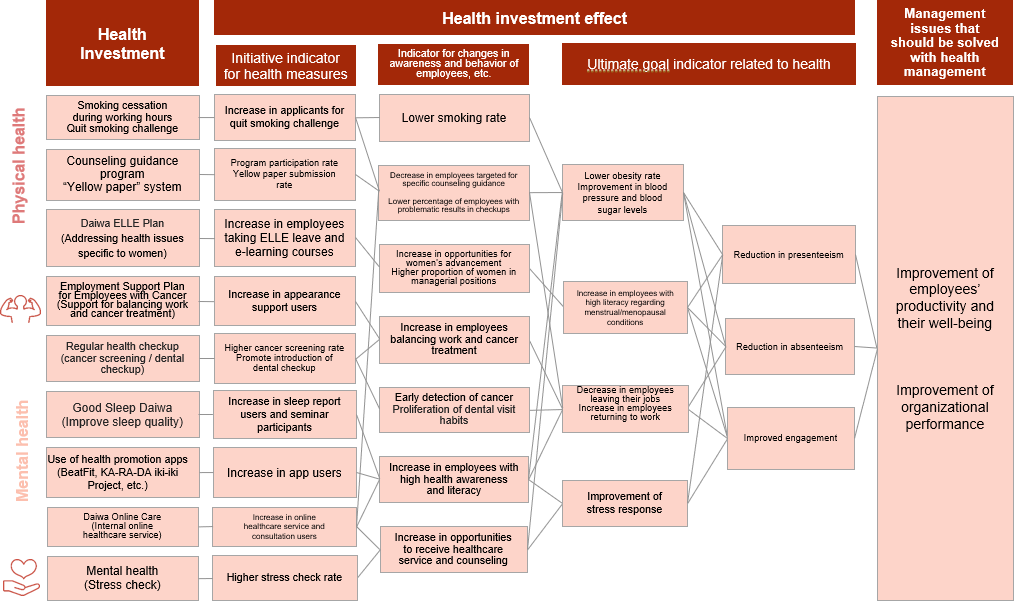
Health issues
As the obesity rate tends to increase with age, it is necessary to increase health awareness when people are still young. The younger generation, in particular, has lifestyle issues, such as a high smoking rate in men and upward trends in the rate of skipping breakfast observed in both men and women. This suggests that measures to maintain a proper lifestyle are important, along with obesity measures.
As for the risk of lifestyle-related disease, the number of people with the level of risk requiring specific counseling guidance is trending upward gradually both in men and women.
| Key area | Health issue |
|---|---|
| Lifestyle | Decreasing employees with health risk (obesity and high blood pressure, in particular) and establishing a healthy lifestyle (smoking, exercise, eating habits, better quality of sleep, etc.) |
| Younger generation | Improving the health awareness and health literacy of the younger generation |
| Women | Addressing health issues specific to women, increasing opportunities for women's advancement |
| Cancer | Early detection and early treatment of cancer, support for balancing work and cancer treatment |
| Mental health | Acquiring stress handling skills, early detection of mental health problems |
Examples of Major Initiatives and Results of Initiatives
Increased Use of Daiwa Online Care
We offer "Daiwa Online Care," an online healthcare service that is available nationwide, and the use of the service is expanding. The number of online consultations provided per year exceeded 1,000 with increasing use of the service particularly from branches across Japan.
Daiwa Online Care provides consultation on health checkup results and mental health, and smoking cessation outpatient care, in addition to ordinary healthcare. (Costs to be borne are healthcare service fees and medication costs only.) Gynecological care commenced in April 2023.
[Diseases eligible for the service]
Pollen allergy, allergic rhinitis, chronic hives, hypertension, diabetes mellitus, dyslipidemia, digestive diseases (reflux esophagitis, chronic gastric discomfort/sensation of gastric distension, gastritis, irritable bowel syndrome, etc.), respiratory diseases such as asthma, hyperuricemia, chronic backache, chronic headaches, smoking cessation outpatient care/consultation (doctor/public health nurse), sleep apnea testing, gynecological care/consultation, mental health consultation (psychiatrist/clinical psychologist), physical health consultation (industrial physician)
[Prescription drugs]
Mailed to employee's home (with the postal fee paid by the company)
[Flow of usage]
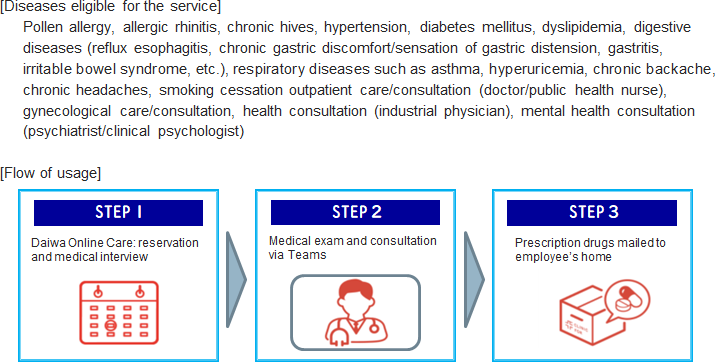
Daiwa ELLE Plan +
Women have various health issues depending on their life stage, and the national government encourages men and women to deepen their understanding of each other's health issues associated with gender differences, while promoting health support that takes gender differences into account. Against this background, we have provided women's menopause support, established ELLE leave (leave for menstrual/menopausal conditions or infertility treatment), improved employee health literacy, and enhanced support for balancing work and infertility treatment. As a result, various effects have been shown, such as improved productivity, reduction in the rate of employee turnover due to infertility treatment, and increase in women in managerial positions.
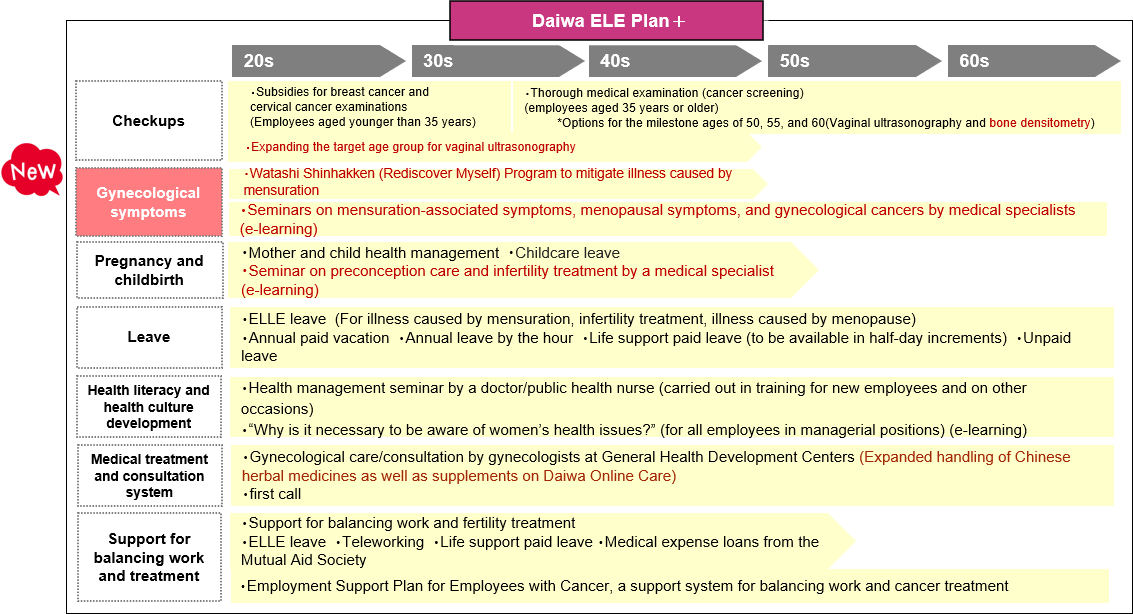
- *Newly added measures are shown in red.
- *The number of days off taken under the ELLE leave system totaled 5,174 in FY2024.
- *In October 2024, we implemented a three-year Femtech program for the mitigation of disorder and stress caused by menstruation (by investing about ¥1.3 million,) and 225 female employees participated in the program. In the post-program questionnaire survey, 67.8% of respondents answered, "Could identify changes in my condition," 87.3%, "My health literacy improved," 73.8%, "Could take actions to maintain my performance level," and 86.1%, "Can now take actions and think more positively."
Continuous Improvement in Female Cancer Screening Rate
Since FY2019, cancer screenings have been integrated into the regular health checkup items, resulting in a substantial improvement in the screening rate. The proportion of female employees receiving the most recent cervical cancer screening and breast cancer screening is around 80% for both types of screening.
Trends in female cancer screening rate (younger than age 35)
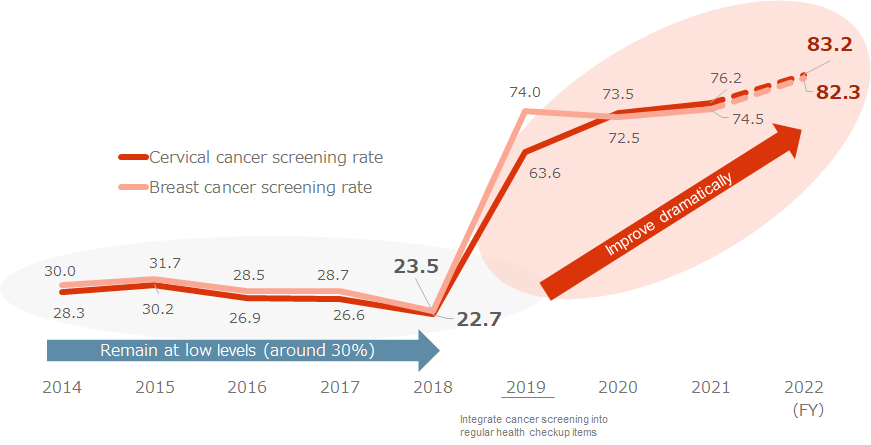
- (Source)Daiwa Institute of Research
Upward Trend in Younger Generation with Exercise Habits
The proportion of young employees (in their 20s and 30s) with exercise habits is consistently increasing, for both men and women. The upward trend continued even during the COVID-19 pandemic in 2020, and we consider this to be due to Beatfit*, a fitness app introduced in 2019, helping to attract employees who were not in the habit of exercising.
We also urge employees to participate in KA-RA-DA iki-iki Project and continue to enhance their awareness of healthy lifestyles.
- *Users in their 20s and 30s account for nearly 50% of the accumulated total new users since the start of the service in FY2019.
Proportion of employees with exercise habits
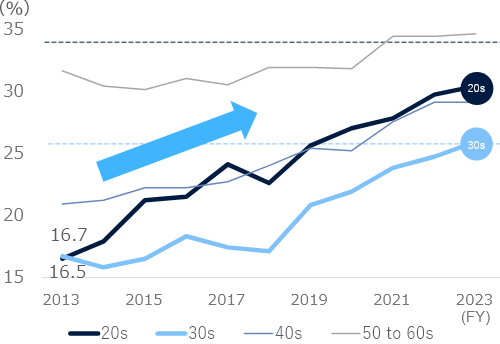
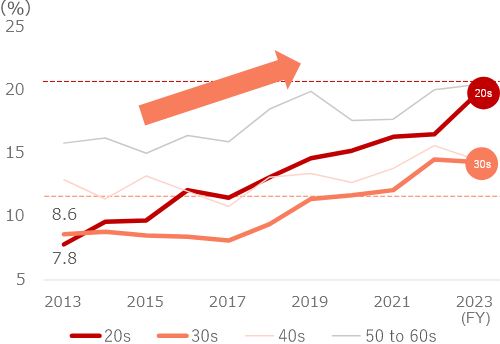
- (Source)Created by Daiwa Institute of Research by using the KOSMO information analysis system
- Note:The percentage of respondents who answered in the regular health checkup interview sheet that they "are in the habit of exercising sufficiently to sweat lightly for over 30 minutes a time, at least 2 times a week, for over a year "
- Note:We have been certified for six consecutive years as a 'Sports Yell Company,' a designation by the Japan Sports Agency for organizations that actively promote and support sports activities to improve employee health.
Expansion of Mental Health Support (Mindfulness Training)
Generally, employees in their first and second years are more likely to feel stress under a new environment. We have therefore introduced Mindfulness Training for new employees as an initiative for mental health. The training is provided in collaboration with psychiatrists from Keio University School of Medicine and customized to the Group.
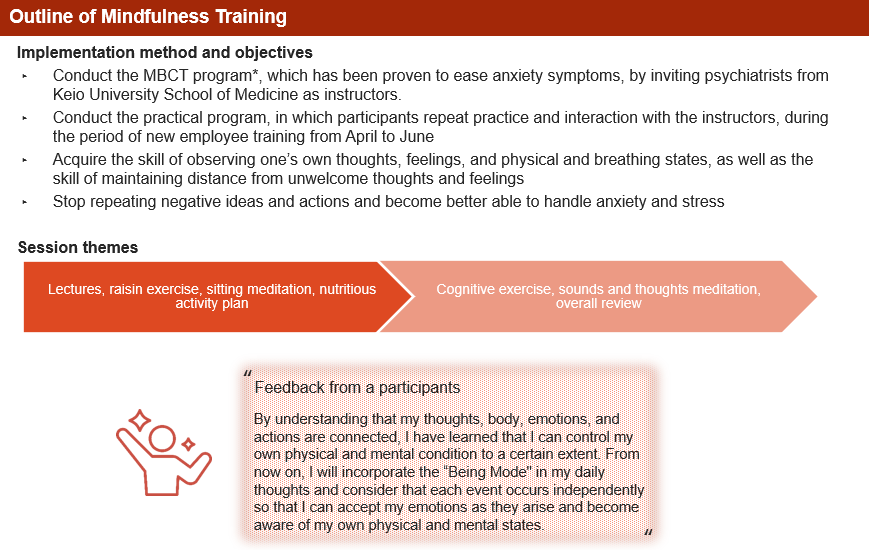
- *MBCT program: Mindfulness-based cognitive therapy
Support Activities
The Group actively collaborate with universities and high schools in research related to health and productivity management. In addition, we engage in support activities by sharing our expertise in health management with partner companies and other organizations, and by jointly implementing related initiatives.
Assisting Companies with Strategic Well-Being Management
Daiwa Institute of Research (DIR), which belongs to our Group, has expertise in the medical insurance system, which it has gained by operating in the social insurance field. Based on this expertise, the company provides customers with support for the implementation of their Data Health Plans, health management consulting service and solutions that meet the needs of individual customers. Also, it offers a standard platform-type core operational service with flexible scalability and advanced security to health insurance associations and is taking the top spot in the market. Going forward, it will deliver a range of health-tech services in one package to assist corporate customers with well-being management.
In 2025, DIR launched the Hearbit service to help employees access well-being support service more smoothly. Via the smartphone app., they will be able pursue their own health and happiness on a daily basis. For their companies, the well-being of employees and resulting workplace comfort will help boost the companies' productivity. Moreover, the central management and visualization of dispersed employees-linked data will make it possible for the companies to show their human capital information to investors and job-hunting students and workers. Companies can thus maximize their return on investment in human capital while raising employees' engagement.
Based on this secure system, DIR will contribute to the enrichment of employees' lives and enhancement of corporate value through the analysis of data accumulated in their service system.
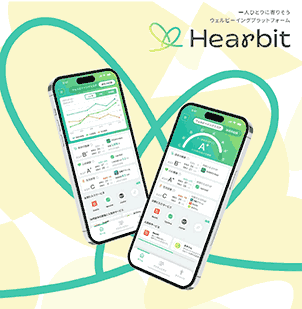
External Evaluations
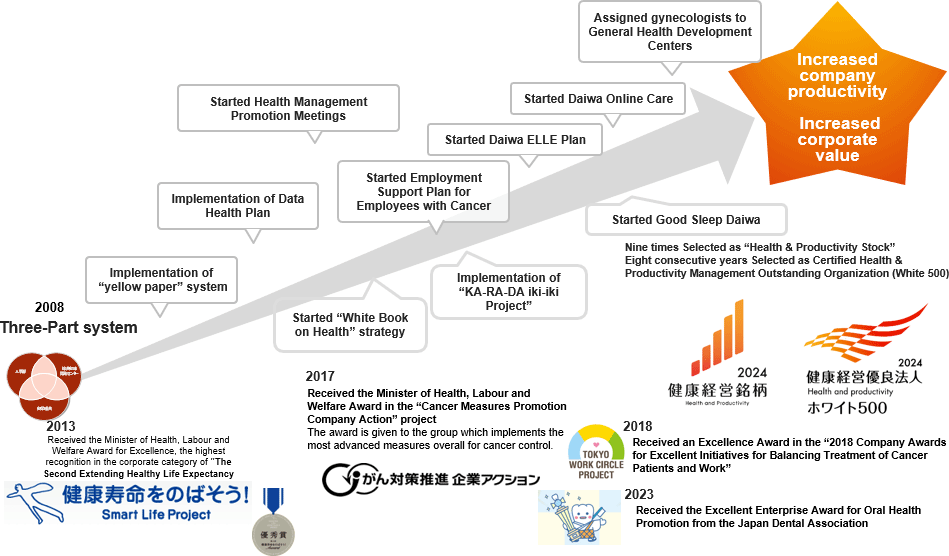
- *We explain the Group's health management initiatives to business partners who have made inquiries.
Other related data
| FY2022 | FY2023 | FY2024 | |||
|---|---|---|---|---|---|
| Obesity rate (30s)*1 | Men | 25.7% | 26.2% | 27.6% | |
| Women | 9.9% | 9.6% | 9.7% | ||
| Smoking rate | Men | 27.1% | 27.3% | 27.2% | |
| Women | 6.2% | 6.2% | 6.1% | ||
| Exercise habits rate | (20s) | Men | 28.5% | 29.9% | 31.4% |
| Women | 16.9% | 19.2% | 18.0% | ||
| (30s) | Men | 23.8% | 24.3% | 27.3% | |
| Women | 13.7% | 13.2% | 14.7% | ||
| Proportion of employees taking enough rest through sleep | 67.9% | 65.8% | 64.5% | ||
| Percentage of loss from presenteeism*2 | 12.6% | 13.9% | 14.5% | ||
| Average of absenteeism*2 | 3.1 days | 3.9 days | 4.0 days | ||
| Engagement survey*3 | 79% | 80% | 81% | ||
| Female ratio in managerial positions*4 | (consolidated) | 16.9% | 18.4% | 20.4% | |
| (Daiwa Securities alone) | 19.9% | 21.1% | 23.2% | ||
| Stress check rate | 91.3% | 93.1% | 93.6% | ||
| Ratio of employees with high stress | 11.2% | 10.0% | 9.4% | ||
| Regular health checkup rate | 100% | 100% | 100% | ||
| Medical institution attendance rate for employees with problematic results in regular health checkups | 82.9% | 82.2% | 81.4% | ||
- *1Target: Reduce the obesity rate for employees in their 30s by 30% from FY2018 by 2027 (men 20%, women 8%). From FY2021, the target was changed from the obesity rate at age 35 to the obesity rate for employees in their 30s.
- *2A total of 12,795 employees responded to the survey for FY2024 (with the response rate reaching 100%). The average of absenteeism was calculated by including absence from illness and injuries in the target.
- *3Sustainable engagement implies employees' great commitment to making contributions to the achievement of the organizational targets and strong sense of belonging to their organizations, which can be maintained in a productive working environment and on the precondition that the employees are healthy both physically and mentally. According to Towers Watson, companies with high scores in terms of sustainable engagement tend to exceed the industry's average growth rate in their business. The awareness survey has been conducted on a group-wide basis since FY2022. (The figures are for the surveys conducted in the latter half of the fiscal year, respectively). To the survey conducted in FY2024, 12,169 employees replied, and the response rate reached 91%. The figures were provided by the survey partner Towers Watson.
- *430% in the 2030s
- *We hold safety and health committee meetings with the participation of the employee unions. For FY2024, we had a total of 35 occupational and commuting incidents (such as minor injuries).
- *Kenko Keiei, which is often translated as "health & productivity management" in English, is a registered trademark of Non-Profit Organization Kenkokeiei.